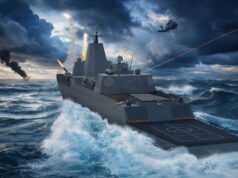NATO Secretary General Jens Stoltenberg praised HMS Queen Elizabeth and the example she sets for the alliance at an informal meeting of EU Defence Ministers.
“We visited a UK aircraft carrier, the HMS Queen Elizabeth, this is the first aircraft carrier in the world which is designed to operate fifth generation aircrafts. It carries US Marines, it is protected by a Dutch frigate, and it’s on its way to the Pacific. And I can hardly think about any stronger and better example of how Europe and North America are working together in NATO to protect us all and it’s great to be able to see this just off the coast of Portugal today.
I’m also of course looking forward to the dinner with the EU Defence Ministers, we will discuss NATO-EU cooperation. We have achieved a lot and I think it is extremely important that we continue to work together, NATO and the European Union, because as we share the same neighbourhood, we also address many of the same crisis’, we have seen that in Belarus, in Ukraine and in Afghanistan.
And I think we can step up and further strengthen our cooperation when it comes to working on the resilience of our societies, infrastructure, climate change and also standing up for the rules based international order.”
What is the UK Carrier Strike Group doing?
HMS Queen Elizabeth is the deployed flag ship for Carrier Strike Group 21 (CSG21), a deployment that will see the ship and her escorts sail to the Asia-Pacific and back. CSG21 will see the ship along with the Strike Group work with over 40 countries from around the world. The Strike Group will operate and exercise with other countries Navies and Air Forces during the 7 month deployment.
The Carrier Strike Group includes ships from the United States Navy, the Dutch Navy, and Marines from the US Marine Corps. As well as British frigates, destroyers, a submarine, two RFA supply ships and air assets from 617 Sqn, 820 NAS, 815 NAS and 845 NAS. This is the largest deployment of Fifth Generation Fighter Jets at sea in history.












At present we wouldn’t have a carrier strike group if we didn’t have access to NATO (mainly US) assets.
Or in the alternative: we do have one that works and we are working it up and learning new skills on 5th Gen Planes + 5th Gen carrier all together with our allies?
And it sends a much clearer message as to NATO collaboration, intent and capabilities that a load of communiques?
But not 5th generation AWACS.
Because 5th gen AWACS doesn’t exist yet?
Great as the E2D is, it is at best 4.5 Gen and probably really 4th gen…..
maybe a 3gen++?
Why would it have a 5th gen AWACS?
Oh sour grapes continiulsy, how about we would and do have a carrier battle group without NATO allies, just less airframes and less two escorts. Or how about as it’s a UK asset, it is therefore also a NATO asset, working for and behalf of NATO. Big boys games, big boys rules, try to see the bigger strategic picture, it’s not hard to do.
Another way of seeing things.
List the nations of the world and work out how many can even do what the RN is doing now, even with a USMC contingent, which will not always be necessary but useful to have.
You’ll find it a very small list….
This capability is been regenerated, it takes time.
Well said Daniele 🇬🇧
UK pilots etc have been operating in US forces for years, not least to maintain carrier ops experience, so why not accept a USMC squadron & be glad we’ve finally restored CSG capability?
This CSG is all the more significant and sends a more powerful signal to China because it includes some US aircraft, a US destroyer and a Dutch frigate etc.
eu